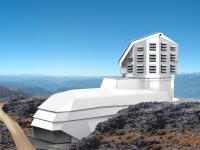
All the sky – all the time: UK astronomers debate involvement in the Large Synoptic Survey Telescope.
Astronomers will discuss the case for UK involvement in the Large Synoptic Survey Telescope project (LSST) on Monday 23 June at the National Astronomy Meeting in Portsmouth. The LSST will be sited at Cerro Pachón in the Chilean Andes and will have a primary mirror 8.4 metres in diameter, making it one of the largest single telescopes in the world, as well as the world’s largest digital camera, comprising 3.2 billion pixels. It will achieve first light in 2020 and its main sky survey will begin in 2022.
Uniquely, the LSST will be able to see a large patch of sky, 50 times the area of the full Moon, in each snapshot. Also it will move quickly, taking more than 800 images each night and photographing the entire southern sky twice each week.
The greatest movie ever made?
A powerful data system will compare new images with previous ones to detect changes in brightness and position of all the objects detected. As just one example, this could be used to detect and track potentially hazardous asteroids that might impact the Earth and cause significant damage. Billions of galaxies, stars and solar system objects will be seen for the first time and monitored over 10 years. Ultimately, the goal is to record the greatest movie ever made.
LSST is a partnership between public and private organizations and is led by the US. The unique scientific opportunities presented by LSST have led to the formation of a consortium of astronomers from more than 30 UK universities to seek funding from the Science and Technology Facilities Council to support UK participation in the project.
The LSST:UK Project Scientist, Sarah Bridle from the University of Manchester, said, “Every night LSST will provide millions of alerts signalling objects that have changed on the sky. We want to compare these to earlier observations and other data including that from the Square Kilometer Array, to find out what they are – from exotic superluminous supernovae to colliding asteroids. Over the whole of the next decade, LSST will also measure the approximate distances to billions of galaxies, which will allow us to learn the nature of the mysterious dark energy that seems to be making the Universe expand faster and faster."
Steve Kahn, the LSST Director added, "I am delighted that the UK is seriously considering participation in LSST. The UK's traditional strength in survey astronomy and the pioneering work done through the Zooniverse project to engage the public make it a natural partner for us. We would greatly value the contribution that the UK astronomy community would bring to enable the success of LSST."
"LSST offers tremendous opportunities for the training of young researchers in the computational skills needed to meet the 'Big Data' challenges prevalent in both public and private sectors today. LSST is already driving research into the management and manipulation of multi-Petabyte datasets in the US and we are sure that our involvement in the project will stimulate similar developments in academia and industry in the UK." The LSST:UK Project Leader, Bob Mann, Institute for Astronomy, University of Edinburgh
Science themes
The science themes of the LSST encompass astronomy, physics, chemistry, earth science, space science, mathematics, technology and computing, and the discoveries made by the LSST will be used to construct educational materials that will be freely available to schools and the public. Andrew Norton from the Open University, the LSST:UK Education and Public Outreach Coordinator, said, "The LSST will allow us to see the night sky changing in front of our eyes and everyone can get involved to understand how the Universe works. The LSST will really show us what a dynamic place the Universe is."
Citizen science
The LSST will provide unprecedented access to data, allowing for new kinds of citizen science and discovery. In recent years, the Zooniverse project has pioneered citizen science investigations of data in astronomy, enabling more than one million members of the public to explore data in projects such as Galaxy Zoo and Planet Hunters. The Zooniverse's Robert Simpson, the LSST:UK Public Data Coordinator from Oxford University, noted, "The citizen science and amateur astronomy communities around the UK, and the world, will be able to access the amazing data that comes out of the LSST. The potential for discovery will be on a scale we haven't seen before."
The Large Synoptic Survey Telescope (LSST)
The LSST will be sited at Cerro Pachón in the Chilean Andes at an altitude of 2715m. The primary mirror diameter is 8.4m, making it one of the largest single telescopes in the world. It also contains secondary and tertiary mirrors with diameters of 3.4m and 5.2m respectively. It will contain the world’s largest digital camera, comprising 3.2 billion pixels (3200 Mpix) in a circular array of 189 detectors. The size of the camera detector is 63cm across. It will generate 30 Terabytes (30,000 Gb) of data every night.
It will achieve first light in 2020 and its main sky survey will begin in 2022. The scale of the technical challenges involved in storing and analyzing LSST’s data are daunting, and researchers are already starting work in earnest on the project.
Learn more at www.lsst.org.
Image gallery
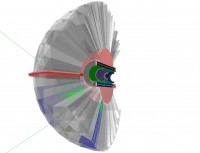
The Edinburgh nuclear physics group has led new research indicating the surface of heavy atomic nuclei comprises a thin "skin" of neutrons, having an average (root mean square) radius around 0.15 millionths of a nanometre larger than that of the protons. A paper co-authored by the School's Prof. Dan Watts has been published as an Editor's Suggestion and features in the commentary section of the current issue of Physical Review Letters.
Dan explains the background to the paper:
"The experiment provides the first measurement of the neutron skin using an electromagnetic probe. This allows a new level of precision in the determination of neutron skin properties and has different systematic errors to other attempts. The neutrons in the nuclear surface were measured to have a more diffuse distribution than the protons. The new results discriminate between nuclear theories in common use but also provide new constraints on how nuclear matter behaves as it is compressed. This information guides the latest theories of neutron stars affecting the predicted star radius for a given mass, possible star cooling mechanisms and gravitational wave emission. The neutron skin is like a mini laboratory for neutron star physics!"
The initial data analysis was carried out by Claire Tarbert who now works as a medical physicist, developing new diagnostic devices for the UK National Health Service.
"This paper arose out of a project I worked on with Dan Watts that formed the basis of my PhD thesis. I’m really pleased to see it published, its been a great project to be a part of.
"I now work for the NHS as a medical physicist. My current role involves collaborating with clinicians, other physicists, and engineers to develop new medical devices (either pieces of software or hardware) mainly for ophthalmic applications. While my knowledge of neutron skins doesn’t come up too often in this job, I find that I use the other skills that I developed during my nuclear physics PhD on an almost daily basis. Through developing hardware for nuclear physics experiments, performing Monte Carlo simulations and data analysis, I gained programming skills and an understanding of electronic and mechanical engineering. That experience, together with the scientific writing skills I picked up as I put together my thesis, I now find invaluable." Claire Tarbert, NHS Medical Physicist
Neutron skin of 208Pb from coherent pion photoproduction: C.M. Tarbert, D.P. Watts, D.I. Glazier et al
Image gallery

Are men more promiscuous than women? The results of the latest National Survey of Sexual Attitudes and Lifestyles (Natsal) appear to suggest so. However, in a comment in The Lancet - one of the most prestigious medical journals in the world - Tom Underwood has highlighted that this is mathematically impossible.
Natsal, one of the largest and most comprehensive surveys on sexual behaviour in the world, aims to provide
much-needed up-to-date and accurate information regarding sexual practices in the UK. There have been 3 Natsal surveys: in 1990-1991, 1999-2001, and 2010-2012. The data from these surveys is widely used, and have played an important role in shaping sexual and reproductive health policy in the UK.
The results of the latest survey have been published in The Lancet, and have also received widespread media coverage.
One of the results of the survey, which was picked up by BBC News and The Telegraph, is that the average number of (opposite-sex) sexual partners which a person has had throughout their lifetime differs significantly between men and women - it is much higher for men. Specifically, the values are 14.1 for men and 7.1 for women for the age range 16-74 years.
"In Natsal, the average for men is twice that for women. Half the time, for men, it seemingly takes one to tango." Tom Underwood, Institute for Condensed Matter and Complex Systems
In his comment, Tom pointed out that the mean lifetime number of opposite-sex sexual partners is necessarily identical for men and women, given the following assumptions: firstly, that the population under consideration consists of equal numbers of men and women; and secondly, that for each member of the population, all of their sexual partners also reside within the population. With this in mind, he then suggested that the large difference in the averages for men and women obtained from Natsal casts doubt on the extent to which the survey results reflect the true sexual behaviour of the general population.
There are a number of explanations for the discrepancy in the averages. One is that either men are over-reporting or women are under-reporting their number of lifetime sexual partners. Another possibility is the breakdown of one or both of Tom's assumptions - which at first glance appear reasonable with regards to the general population. In this regard, the authors' reply to Tom's comment is interesting. In the reply, the authors of the Natsal study suggest further possible reasons for the discrepancy, including:
1) Under-representation of female sex workers in the survey.
2) Men having sex with foreign women while either the men are abroad, or the foreign women are visiting the UK, more than the opposite situation (ie women having sex with foreign men while either the women are abroad or the foreign men are visiting the UK). The idea is that foreigners are not picked up by the survey, violating the assumption of a closed population.
3) More complicated effects involving generational changes in promiscuity, the fact that men generally take younger sexual partners, and the fact that women generally live longer than men.
The source of the discrepancy is not clear, and requires further investigation. For the population 'of all human beings who have ever lived' Tom's assumptions are valid, and the averages are therefore identical. This reflects the truth that 'it takes two to tango': each opposite-sex partnership involves one man and one woman, and hence promiscuity (which, at the risk of misusing the word, we have here equated to the number of lifetime sexual partners) is necessarily the same for both sexes. The crux of Tom's observation is that this truth is not borne out in the results of Natsal.
Tom is based in the Computational Materials Physics research group, in the School's Institute for Condensed Matter and Complex Systems.
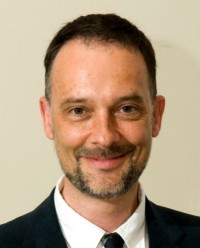
Prof. John Peacock has been jointly awarded the Shaw Prize in Astronomy. He shares the award with Professors Daniel Eisenstein (Harvard University) and Shaun Cole (Durham University).
The 2014 Shaw Prize recognises the achievements of two large-scale sky surveys: the UK-Australian Two-degree Field Galaxy Redshift Survey (2dFGRS) and the USA-led Sloan Digital Sky Survey (SDSS). John Peacock was a co-leader of the 2dFGRS, which catalogued 220,000 galaxies between 1995 and 2002, a tenfold leap in the size of such studies.
For their contributions to the measurements of features in the large-scale structure of galaxies used to constrain the cosmological model including baryon acoustic oscillations and redshift-space distortions. Shaw Prize in Astronomy for 2014 citation
Sky surveys
The distribution of galaxies makes colossal patterns in space, hundreds of millions of light-years in extent. The form of this structure is set by the action of gravity over the entire history of the universe, and its detailed properties tell us much about the overall nature of the universe.
The characteristic size of these structures gives a natural standard ruler (the so-called "Baryon Acoustic Oscillation" scale) which allows us to measure the expansion history of the universe. The size of the velocities associated with the growing structure gives a test of Einstein's theory of gravity (measured via "redshift-space distortions"). These are two distinct applications that are possible with large surveys of the three-dimensional positions of galaxies.
The 2dFGRS was an incredibly successful project, made possible by many essential contributions from members of a big team. We all felt at the time that we were doing something revolutionary, and it's wonderful to see this work get the recognition it deserves. John Peacock, Professor of Cosmology, Institute for Astronomy, University of Edinburgh
The Shaw Prize
The Shaw Prize is an international award to honour individuals who are currently active in their respective fields and who have recently achieved distinguished and significant advances, who have made outstanding contributions in academic and scientific research or applications, or who in other domains have achieved excellence. The award is dedicated to furthering societal progress, enhancing quality of life, and enriching humanity's spiritual civilization.
Preference is given to individuals whose significant work was recently achieved and who are currently active in their respective fields.
The Shaw Prize consists of three annual awards: the Prize in Astronomy, the Prize in Life Science and Medicine, and the Prize in Mathematical Sciences. Each prize carries a monetary award of one million US dollars.
The Shaw Prize, established under the auspices of Mr Run Run Shaw in November 2002, is managed and administered by The Shaw Prize Foundation based in Hong Kong.
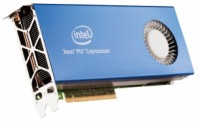
EPCC, the supercomputing centre at the University of Edinburgh, has been designated an Intel Parallel Computing Center (IPCC) through a prestigious grant from Intel – a distinction currently held by only a handful of parallel computing centres worldwide.
Through this new partnership, EPCC will collaborate with Intel to optimise several open source high-performance computing (HPC) applications for Intel’s latest parallel processor architectures.
Incredible opportunity
Designation as an IPCC gives us an incredible opportunity to work on a range of important, and widely used, simulation codes to ensure that they can utilise the latest Intel hardware effectively. ARCHER, the UK’s national HPC service hosted and supported by EPCC is a Cray XC30 system with Intel® Xeon® Processor E5-2697 v2,” continued Mark. “It is therefore essential that mainstream simulation packages, which account for more than half the usage of ARCHER, are properly optimised to get maximum benefit from this technology. Prof. Mark Parsons, EPCC Executive Director (Research & Commercialisation).
“The centre will build on a range of world-class projects, collaborations, and initiatives that EPCC is currently involved with, including European HPC projects such as PRACE and CRESTA and global simulation initiatives, such as the G8-funded Nu-FuSE project,” said Adrian Jackson, Research Architect at EPCC and leader for EPCC’s involvement in NU-FuSE.
Dr Michèle Weiland, Project Manager at EPCC, said: “The initial target for optimisation and porting work are codes that EPCC is already very familiar with, have had experience parallelising and optimising for standard distributed memory parallel systems, and are used by a wide community of simulation scientists for world leading science on global challenges such as energy security, climate change, and future manufacturing technologies.”
"Intel is pleased to expand our Intel® Parallel Computing Center program in collaborating with EPCC," said Bob Burroughs, Director of Technical Computing Ecosystem Enabling at Intel. "This new centre creates an opportunity for Intel and EPCC to innovate and optimize applications which benefit industry and science in Europe and globally."
Performance tuning
EPCC’s Application Consultants, who are experts in the performance tuning of HPC modelling and simulation codes, will undertake the code porting and optimisation tasks. A further aim of the IPCC is to leverage the world-leading hardware available at EPCC, and its extensive training programmes, to provide training and expertise to a wider range of academic and industrial participants in the UK and Europe on efficiently using Intel hardware for computational simulation.
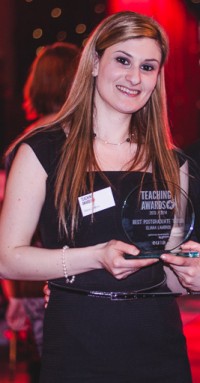
Congratulations to Eliana Lambrou, who has won the Best Postgraduate Tutor Award at EUSA's Teaching Awards. Charles Cockell was runner-up for the Van Heyningen Award for Teaching in Science and Engineering.
Best Postgraduate Tutor Award
This award recognises postgraduate tutors who:
• Stimulate interesting and engaging discussion in tutorials
• Make lab demonstrations fun
• Provide helpful feedback on students' work and are approachable with questions.
"The act I most admire her for was volunteering her own research time to tutor students in one-to-one sessions after class... She is a very modest woman and would not think she is worthy of this praise but her actions prove otherwise." Student nomination for Eliana Lambrou
Eliana Lambrou, who is based in the School's Particle Physics Theory group, said: 'I was delighted when I received the invitation for a fancy, black-tie event for the Teaching Awards, at which I was nominated for the Best Postgraduate Tutor Award. It is always good to see that your work is recognised by the students and I want to thank each of them for this acknowledgment. Their feedback on our teaching just makes us better!!!
'I want to thank my fellow tutors because of their big contribution in the effort to deliver good and useful tutorials, but mostly a big thank you goes to the organiser of the courses that I was tutoring, Kristel Torokoff, who has been a lovely teaching mentor and an inspiration to me.'
The Van Heyningen Award for Teaching in Science and Engineering
Charles Cockell, Professor of Astrobiology, was runner-up for this award. He said: 'I'm really delighted to be nominated by my students. Most importantly it shows an enthusiasm for the teaching of interdisciplinary science.'
"All of the students agree that he is not just an international superstar professor who has worked for NASA, he is also the best professor in general... when he delivered the last lecture in astrobiology dressed up as an alien, who had to feed every ten minutes, we could not help it: we were all in love with this amazing educator from another world!" Student nomination for Charles Cockell
Image gallery

The LUX (Large Underground Xenon) dark matter experiment is seeking the first ever direct detection of dark matter.
LUX uses a 370kg liquid xenon time-projection chamber that aims to directly detect galactic dark matter in an underground laboratory 1 mile under the earth, in the Black Hills of South Dakota, USA.
The University of Edinburgh is a key member of this international project, and its effort is led by Dr Alex Murphy of the School's Nuclear Physics group. Dr James Dobson, a postdoctoral researcher in the Edinburgh team, is presently in charge of on-site operations of the project.
LUX has featured prominently in a series of recent BBC news features. Learn more about the project by following the links below.
Image gallery
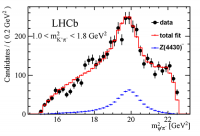
Edinburgh physicists, working on the LHCb experiment at CERN, have confirmed the existence of an exotic combination of four quarks/antiquarks that does not fit into the normal particle zoo of baryons and mesons.
A new measurement performed by the LHCb collaboration, one of the four large experiments at the LHC at CERN, has confirmed the existence of the exotic object labelled the Z(4430)-. This particle does not fit into the pattern of particles we have seen up to now. The LHCb result confirms an observation made by the Belle collaboration in 2008 that was later questioned and so resolves this previously unclear situation.
We and everything around us are made of atoms, and atoms are made in turn of smaller constituents. Atomic nuclei are orbited by electrons. The protons and neutrons that form atomic nuclei consist of three fundamental particles, called quarks, bound together. Other combinations of quarks can occur - particles containing two bound quarks (mesons) are also seen in nature. However, until now all particles containing quarks (hadrons) have conformed to one of these two types; quarks seem to like to come in twos or threes.
However, the underlying theory of quantum chromodynamics (QCD) that describes the behaviour of quarks allows for many different quark combinations, such as four quark states, to bind together into hadrons. Over the last forty years many searches for such exotic states have been performed but until now there was no conclusive proof of their existence. Several more mundane explanations for the Z(4430)- signal seen by Belle had been put forward, but the LHCb result establishes that for the first time we have seen the “smoking gun” signal for resonant behaviour of a particle contains at least four quarks/antiquarks.
The strange name, Z(4430)-, indicates that the particle has a mass of approximately 4430 MeV/c2, roughly four times heavier than a proton. In addition, the “-“ sign tells us that the state is negatively charged. The LHCb collaboration have also made a measurement of the spin and parity of this state, two fundamental properties (quantum numbers) that characterise its nature.
"This is a fantastic result from the LHCb collaboration. It confirms previous signs of this exotic state and shows, for the first time, that it has has the characteristic behaviour of a resonance. In addition we have also been able to pin down the quantum numbers and properties of this state with higher precision than previous experiments. The next step is to look for further signs of this state in the large sample of data that we have already collected."Greig Cowan, STFC Ernest Rutherford Fellow at the University of Edinburgh and one of the lead analysts on this result.
"This is tremendous result, demonstrating the existence of new exotic hadronic states and shows the power of the large dataset collected by LHCb to make new discoveries."Matthew Needham, Chancellor's Fellow at the University of Edinburgh, is the UK physics co-ordinator for the LHCb experiment.
Image gallery

The £43 million ARCHER (Academic Research Computing High End Resource) system will provide high performance computing support for research and industry projects in the UK.
ARCHER will help researchers carry out sophisticated, complex calculations in diverse areas such as simulating the Earth’s climate, calculating the airflow around aircraft, and designing novel materials.
Its magnitude and design will enable scientists to tackle problems on a scale that was previously thought impossible.
The system, at the University’s Advanced Computing Facility at Easter Bush, has up to three and a half times the speed of the HECTOR supercomputer system, which it replaces.
UK Research Data Facility
ARCHER’s twin rows of sleek black cabinets are supported by the newly-installed UK Research Data Facility.
The system brings together the UK’s most powerful computer with one of its largest data centres. This creates a facility to support Big Data applications, which has been identified by the UK Government as one of its Eight Great Technologies.
The building housing the ARCHER system is among the greenest computer centres in the world, with cooling costs of only eight pence for every pound spent on power.
“The University of Edinburgh has for many decades been a pioneer in High Performance Computing. Now that Big Data is reaching into an even greater range of areas we are delighted to have the ARCHER facility and its support at Edinburgh. Together with the UK Research Data Facility, we and the Research Councils have a facility unique in the UK, combining some of the world's most powerful computers with a vast datastore and analysis facilities. We will work with the Research Councils and UK researchers to generate world-leading research and business impact.” Prof Sir Timothy O’Shea, Principal of the University of Edinburgh
“ARCHER is the highest ranked UK supercomputer on the Top 500 list of November 2013. Based on Intel Xeon E5 v2 processors, the system is designed to deliver sustained performance and scalability, providing researchers and scientists with a powerful, reliable and productive tool.” Stephan Gillich, Director Technical Computing EMEA, Intel
ARCHER was supplied by US computing experts Cray and is funded and is owned by the Engineering and Physical Sciences Research Council (EPSRC). The Massively Parallel Processor uses Cray’s XC30 hardware. Intel’s Xeon E5-2600v2 processor series enables ground-breaking performance, scalability, and maximises energy efficiency.
Systems support for the machine will be provided by the University’s EPCC and Daresbury Laboratory. Science, user and engineering support will also be provided by EPCC.
ARCHER for industry
EPCC's Accelerator programme gives industry on-demand access to the ARCHER supercomputing service.
Image gallery
Astrophysics undergraduate Victoria Weller von Ahlefeld is a co-author of a paper about Gamma-Ray Bursts that was published in the American Journal for Astrophysics this month. She undertook the work at the Max-Planck Institute for Extraterrestrial Physics after the second year of her degree here in the School.
Victoria explains the background to the paper.
Detecting Gamma-Ray Bursts
Gamma Rays are at the most energetic end of the electromagnetic spectrum, allowing them to travel into the depths of the Cosmos. Therefore, Gamma-Ray Bursts (GRBs) can reach Earth from very distant objects, allowing insight into primordial conditions of the Universe. Possible sources of such energy blasts are supernovae, hypernovae or binary neutron star systems, although there is little which is really known about them.
The space telescope Fermi has been in orbit detecting GRBs with the Gamma-ray Burst Monitor (GBM) device since June 2008 and has been triggered on over 900 occasions since. A large volume of data must be analyzed and put into a useful format: the spectral catalog. Spectra extracted from 462 GRBs in years 3 and 4 of the mission supplemented the data from the first two years.
My internship was with the High-Energy Astrophysics group at the Max-Planck Institute for Extraterrestrial Physics during the time when the peak of data analysis was carried out. I was working with David Gruber, a brilliant PhD student in charge of producing a spectral catalog.
Via the IDL (Interactive Data Language) data visualization and analysis platform, 462 GRBs underwent proper readout and visualization. The GBM on Fermi has 14 detectors, of which the best exposed must be selected. After determining the duration of all observed bursts, polynomial background needed to be fitted across a user-defined interval to all suitable detectors. Furthermore, reduced data was used to perform the spectral analysis using four different spectral models, therefore obtaining a compendium of over 3700 GRB spectra.
The Fermi GBM Gamma-Ray Burst Spectral Catalog: Four Years of Data was published in The Astrophysical Journal Supplement Series in March 2014. Following Victoria's work on the data analysis part of the production of the catalog, her name is the third of 32 authors of the paper.

